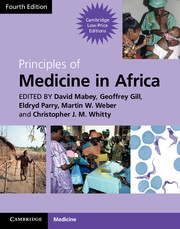Book contents
- Frontmatter
- Contents
- Contributors
- Foreword
- Section 1 Health and disease
- Section 2 Mother and child health
- Section 3 Infection: general principles
- Section 4 Major common infections
- Section 5 Bacterial infections
- 22 Typhoid, paratyphoid and non-typhoid Salmonella infections
- 23 Streptococcus pyogenes and Staphylococcus aureus
- 24 Rickettsial infections
- 25 Brucellosis
- 26 Leptospirosis
- 27 Relapsing fever
- 28 Plague
- 29 Anthrax
- 30 Tetanus
- 31 Diphtheria
- 32 Leprosy
- 33 Cholera
- Section 6 Viral Infections
- Section 7 Protozoal infections
- Section 8 Helminth infections
- Section 9 Fungal infections
- Section 10 Non-communicable diseases
- Section 11 Diseases of body systems
- Section 12 Cancer and Palliative Care
- Section 13 Venoms and Poisons
- Index
- References
28 - Plague
from Section 5 - Bacterial infections
Published online by Cambridge University Press: 05 March 2013
- Frontmatter
- Contents
- Contributors
- Foreword
- Section 1 Health and disease
- Section 2 Mother and child health
- Section 3 Infection: general principles
- Section 4 Major common infections
- Section 5 Bacterial infections
- 22 Typhoid, paratyphoid and non-typhoid Salmonella infections
- 23 Streptococcus pyogenes and Staphylococcus aureus
- 24 Rickettsial infections
- 25 Brucellosis
- 26 Leptospirosis
- 27 Relapsing fever
- 28 Plague
- 29 Anthrax
- 30 Tetanus
- 31 Diphtheria
- 32 Leprosy
- 33 Cholera
- Section 6 Viral Infections
- Section 7 Protozoal infections
- Section 8 Helminth infections
- Section 9 Fungal infections
- Section 10 Non-communicable diseases
- Section 11 Diseases of body systems
- Section 12 Cancer and Palliative Care
- Section 13 Venoms and Poisons
- Index
- References
Summary
The problem in Africa
Plague remains endemic in several parts of Africa (Fig. 28.1). Its incidence in Africa has probably declined over the last century, but it is unlikely ever to be eliminated, and there may even be an upsurge at present (Neerinckx et al., 2010). Africa currently has 95 per cent of the world's human plague, with an estimated 1800 cases per year (WHO, 2010), although data should be interpreted with caution. Good epidemiological studies consistently show that cases of plague are missed and that, conversely, during epidemics it is over-diagnosed. Plague has a very uneven distribution throughout the continent, and over time, with DRC, Madagascar, Tanzania, Uganda, Malawi, Mozambique and Algeria all reporting cases.
The importance of plague does not lie in the fact it is common (it is not), but that it is essential not to miss it when it occurs. This is for the sake of the individual, for health care workers caring for the patient, and for public health reasons. Plague, with its overtones of the Black Death decimating populations in major pandemics, has induced mass panic when potential outbreaks are announced. This panic, which has serious implications for public health, is partially justified. Untreated, even the mildest (bubonic) form has a mortality of over 50 per cent, and untreated pneumonic plague is almost 100 per cent fatal. The risk of infection is, however, very low.
- Type
- Chapter
- Information
- Principles of Medicine in Africa , pp. 338 - 341Publisher: Cambridge University PressPrint publication year: 2013



